COVID-19-Associated Cerebrovascular Events: A Case Series Study and a Literature Review of Possible Mechanisms
- PMID: 36748059
- PMCID: PMC9898811
- DOI: 10.1159/000529122
COVID-19-Associated Cerebrovascular Events: A Case Series Study and a Literature Review of Possible Mechanisms
Abstract
Severe acute respiratory syndrome coronavirus 2 (SARS-CoV-2) affects multiple body systems, including the nervous system. Cerebrovascular accidents can also occur. Patients with comorbid illnesses have severe manifestations and poor outcomes. Despite the proper mechanism of SARS-CoV-2 infection-associated stroke having not yet been settled, various possible mechanisms have been hypothesized. One possibility is that the virus causes endothelial dysfunction and immune-mediated injury. Another possibility is that the trans-neuronal spread of the virus affects brain tissue. In addition, hypercoagulability caused by SARS-CoV-2 infection could lead to a stroke. A virus-induced dysfunction of the renin-angiotensin system could also lead to a stroke. The immune response and vasculitis resulting from SARS-CoV-2 infection are also possible causes via a cytokine storm, immune dysfunction, and various inflammatory responses. SARS-CoV-2 infection may affect calcitonin gene-related peptides and cerebral blood flow and may lead to stroke. Finally, SARS-CoV-2 may cause hemorrhagic strokes via mechanisms stimulated by its interaction with angiotensin-converting enzyme 2 (ACE2), leading to arterial wall damage and blood pressure changes. In this article, we will present seven cases of stroke-associated SARS-CoV-2 infection.
Keywords: Cytokine storm; Hemorrhagic stroke; Immune dysfunction; Severe acute respiratory syndrome coronavirus 2; Stroke.
© 2023 The Author(s). Published by S. Karger AG, Basel.
Conflict of interest statement
The authors declare that they have no competing interests.
Figures
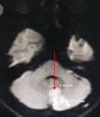

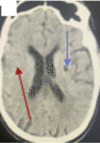
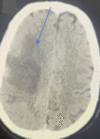
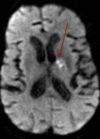
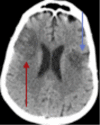


Similar articles
-
Neurological manifestations of SARS-CoV-2: complexity, mechanism and associated disorders.Eur J Med Res. 2023 Aug 30;28(1):307. doi: 10.1186/s40001-023-01293-2. Eur J Med Res. 2023. PMID: 37649125 Free PMC article. Review.
-
COVID-19, Renin-Angiotensin System and Endothelial Dysfunction.Cells. 2020 Jul 9;9(7):1652. doi: 10.3390/cells9071652. Cells. 2020. PMID: 32660065 Free PMC article. Review.
-
Possible mechanism of central nervous system targeting and neurological symptoms of the new-coronavirus (COVID-19): literature review.Eur Rev Med Pharmacol Sci. 2023 Oct;27(19):9420-9428. doi: 10.26355/eurrev_202310_33970. Eur Rev Med Pharmacol Sci. 2023. PMID: 37843354 Review.
-
Brain Renin-Angiotensin System: From Physiology to Pathology in Neuronal Complications Induced by SARS-CoV-2.Anal Cell Pathol (Amst). 2023 Aug 4;2023:8883492. doi: 10.1155/2023/8883492. eCollection 2023. Anal Cell Pathol (Amst). 2023. PMID: 37575318 Free PMC article. Review.
-
A mechanistic model and therapeutic interventions for COVID-19 involving a RAS-mediated bradykinin storm.Elife. 2020 Jul 7;9:e59177. doi: 10.7554/eLife.59177. Elife. 2020. PMID: 32633718 Free PMC article.
Cited by
-
Global research trends on COVID-19 and stroke: A bibliometric analysis.Front Neurol. 2023 Apr 3;14:1147867. doi: 10.3389/fneur.2023.1147867. eCollection 2023. Front Neurol. 2023. PMID: 37077570 Free PMC article.
-
Vascular Alterations Following COVID-19 Infection: A Comprehensive Literature Review.Life (Basel). 2024 Apr 24;14(5):545. doi: 10.3390/life14050545. Life (Basel). 2024. PMID: 38792566 Free PMC article. Review.
-
COVID-19-associated neurological sequelae: A case series on cerebral microbleeds and encephalopathy.Qatar Med J. 2023 Nov 1;2023(4):29. doi: 10.5339/qmj.2023.29. eCollection 2023. Qatar Med J. 2023. PMID: 37920783 Free PMC article.
References
Publication types
LinkOut - more resources
Full Text Sources
Miscellaneous

